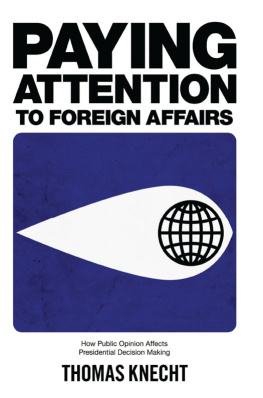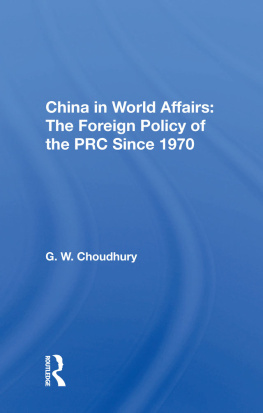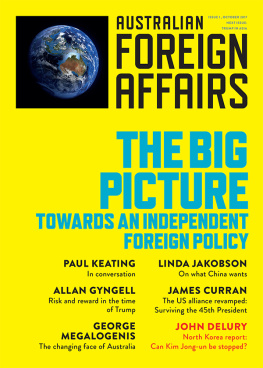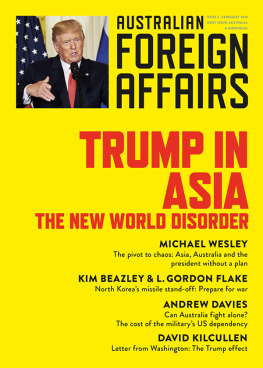ISSUE 9, JULY 2020
AUSTRALIAN FOREIGN AFFAIRS
Australian Foreign Affairs is published three times a year by Schwartz Books Pty Ltd. Publisher: Morry Schwartz. ISBN 978-1-74382-1411 ISSN 2208- 5912 ALL RIGHTS RESERVED. No part of this publication may be reproduced, stored in a retrieval system, or transmitted in any form by any means, electronic, mechanical, photocopying, recording or otherwise, without the prior consent of the publishers. Essays, reviews and correspondence retained by the authors. Subscriptions 1 year print & digital auto- renew (3 issues): $49.99 within Australia incl. GST. 1 year print and digital subscription (3 issues): $59.99 within Australia incl. GST. 2 year print & digital (6 issues): $114.99 within Australia incl. GST. 1 year digital only auto-renew: $29.99. Payment may be made by MasterCard, Visa or Amex, or by cheque made out to Schwartz Books Pty Ltd. Payment includes postage and handling. To subscribe, fill out the form inside this issue, subscribe online at Editor: Jonathan Pearlman. Deputy Editor: Julia Carlomagno. Associate Editor: Chris Feik. Consulting Editor: Allan Gyngell. Digital Editor and Marketing: Georgia Mill. Editorial Intern: Lachlan McIntosh. Management: Elisabeth Young. Subscriptions: Iryna Byelyayeva. Publicity: Anna Lensky. Design: Peter Long. Production Coordination: Marilyn de Castro. Typesetting: Akiko Chan. Cover photograph by Yuichiro Chino / Getty.
Contributors
Anne-Marie Brady is a professor at the University of Canterbury and a global fellow at the Wilson Center in Washington, DC.
Nick Bisley is dean of humanities and social sciences and a professor of international relations at La Trobe University.
James Brown is a non- resident fellow at the United States Studies Centre and a former Australian Army officer.
Danielle Cave is deputy director of the International Cyber Policy Centre at the Australian Strategic Policy Institute.
Andrew Davies is a senior fellow at the Australian Strategic Policy Institute.
Kim McGrath is the author of Crossing the Line: Australias Secret History in the Timor Sea.
Susan Harris Rimmer is Australian Research Council Future Fellow at Griffith Law School.
Max Walden is a reporter and producer at the ABCs Asia- Pacific newsroom.
Penny Wong is the shadow minister for foreign affairs and leader of the opposition in the Senate.
Editors Note
SPY VS SPY
In February, Mike Burgess, the director-general of Australian Security Intelligence Organisation (ASIO), shared details of an elaborate espionage operation recently uncovered in Australia.
The operation, Burgess said, involved a sleeper agent who spent years in Australia establishing his cover and building community ties before being activated. The agent then began providing support to a network of spies who came to Australia, as well as relaying information to his handlers about dissident activities in Australia.
Burgess did not name the nation involved, though he would have known that his predecessor, Duncan Lewis, admitted to Peter Hartcher in the 2019 Quarterly Essay Red Flag that the main source of the existential threat posed by foreign espionage and interference was China.
Burgesss revelation about the presence of sophisticated sleeper cells in Australia may not be all that surprising, especially as such operations have long been a staple of spy novels, movies and television series. The more unexpected aspect was that he chose to reveal these details at all. He did so in Canberra when presenting ASIOs inaugural Annual Threat Assessment a public statement that marks the latest step out of the shadows by Australias intelligence agencies.
These days, Australias domestic spy agency fields media inquiries, and its recent heads have delivered speeches and given press interviews. Australias foreign collection agency, the Australian Secret Intelligence Service (ASIS), was kept secret even from MPs until the 1970s. But its former director-general, Nick Warner, delivered a public address in 2012, and its current head, Paul Symon, recently gave an interview to a podcast.
This decision to come out of the cold partly reflects these agencies need to justify their growing funding and their increasing powers. In the past twenty years, Australias intelligence spending has risen exponentially. In 2001, for instance, ASIOs budget was $61 million; this year it was $573 million. Meanwhile, changes in technology have given agencies enhanced potential to exercise surveillance, including over Australian citizens. The agencies evidently believe they need to both assure the public that these powers will not be misused and to build a case for receiving greater access to private communications and data.
But the need for public engagement also reflects the threats the nations intelligence agencies now face. They are no longer primarily concerned with targeting foreign states or thwarting espionage by rival agencies, but with terrorism, foreign interference and cyber intrusions. Agents cannot simply stalk the halls of power in Canberra and Moscow. Instead, they must interact regularly with businesses, universities, community groups, and telecommunications and social media firms. Some of this will be undercover; much is not.
These trends, which are reshaping the role and focus of intelligence agencies, are only likely to accelerate. The COVID-19 pandemic has exacerbated tensions between China and the West, meaning that Australia will continue to be a target for Chinas vast network of spies. Already, according to Burgess, There are more foreign intelligence officers and their proxies operating in Australia now than at the height of the Cold War. Spying is on the rise, and new technologies are enhancing the data collection and analysis capabilities of Australian agencies and their adversaries.
As these threats evolve, and intelligence agencies enter the public sphere, it will be crucial for citizens to understand the work they do. Just as with any other arm of government, we must ensure that they are fulfilling their main task protecting the nations security capably, efficiently and with restraint.
Jonathan Pearlman
MISSION IMPOSSIBLE
Spying in the age of Xi and Zoom
Andrew Davies
As the world shifts, so do intelligence practices. An intelligence analyst at her desk today worrying about the accuracy of COVID-19 data from China, the origins of a persistent cyberattack or the machinations of a terrorist group with undercover cells in half a dozen countries probably doesnt spend a lot of time reflecting on how much easier her job would have been thirty years ago. But recent developments in geopolitics and technology, as well as a continuing terrorism threat, have been complicating the lives of Australias intelligence community. And these changes have occurred as the nations spy agencies have been emerging from the shadows, which carries the risk of any misjudgements or failures being more widely exposed.
The current intelligence era began in 1991, with the collapse of the Soviet Union the culmination of a battle of intelligence that had lasted forty years. During the Cold War, long careers began and ended with the same adversary and many of the same intelligence challenges in place. In the absence of open conflict between the main protagonists notwithstanding several proxy wars states were determined to strengthen their intelligence capabilities, and their efforts to do so helped to reshape the international order. The United States, for instance, set up a global espionage network that leveraged its alliance relationships. The Five Eyes collaboration between the United States, Australia, Canada, New Zealand and the United Kingdom established intelligence collection sites around the world and took advantage of geography to split intelligence responsibilities between members.
Next page













